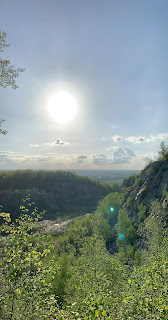Rhythm and Balance
After learning about rhythm, balance, scale, and texture from the reading, I thought it will appropriate to relate this topic to my photographs of nature. Indeed, balance and rhythm is a huge part of our daily lives as it helps us understand our surroundings. However, after observing some of my photographs of nature, I realized that almost each of those photos was asymmetrical. I found it fascinating as the reading stated that "symmetry is not the only way to achieve balance, however. Asymmetrical designs are generally more active" ( Lupton 50). I was conflicted at first when I read that particular statement. I asked myself "how can something be balanced if it's asymmetrical?". Then I realized from my photographs that things don't have to be symmetrical to achieve balance.
I chose the first and second images to show that they can achieve balance regardless of them being asymmetrical. Look at the first image, the sun on the left and the mountain on the right is a counterpoint to each other. Since they are "contrasting elements" (Lupton 50), it will lead the viewers to focus on both the sun and the mountain rather than just focusing on the sun or vice versa. In the fourth and fifth images, I thought it illustrates disrupted symmetry perfectly. Both images would've been symmetrical but since a tall tree and a guy appears slightly off-centered, the two images become a "dynamic counterpoint balance" (Lupton 51). For the last image, I chose the rock balancing I made because I feel it depicts the concept of balance and rhythm working together to create stability.








Wow what beautiful photos!! The one outside of Ormsby is really making me miss campus. I was also conflicted about the idea of asymmetry and how visually things can appear more balanced. Thanks for sharing such insightful thoughts!
ReplyDeleteI really like the picture of the balancing rocks. I think that it fits perfectly with what were were learning this week. It seems like it would take a while to balance those rocks!
ReplyDelete